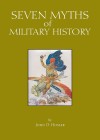by John D Hosler
Hackett Publishing Company, 2022, 185 pp
Paperback ISBN: 97813942033201
Reviewed by: John Nash
Military historians and theorists are often confronted by frustrating historical myths. Sometimes these are quite specific (e.g. a battle, historical figure, or piece of equipment), whereas sometimes they are historical constructs or historical arguments that have gained a life of their own and that come to bedevil the wider scholarship of war and military studies. The collection of chapters in John D Hosler’s Seven Myths of Military History is concerned with dispelling the latter. This is a worthy endeavour because, as the editor of the collection highlights at the very start, these long-enduring military myths affect not only popular imagination but also the thought processes of ‘military professionals, heads of state, and even paramilitary/irregular leaders’.[1] In Australia, many national military myths have already been tackled in two volumes edited by Professor Craig Stockings: Zombie Myths of Australian Military History and Anzac’s Dirty Dozen: 12 Myths of Australian Military History. In Hosler’s collection, the focus is on big myths of military history, covering subjects foundational to all militaries.
The book’s seven chapters explore seven myths in different topics and epochs. The first chapter is written by Professor Andrew Hold and is concerned with the question of whether religion is actually the cause of most wars in history. An interesting question, it is perhaps the least relevant to military practitioners as it goes to the heart of the nature and cause of war at a societal and political level. The main takeaway from the chapter is that it is usually very difficult to separate the causes of a war into nice neat categories: there are generally multiple causes and motivations for war. War being a human endeavour, this observation may not come as a surprise to readers. It is nevertheless an important point, for it is all too easy to reduce the cause of a conflict into one simple explanation, be it power, fear, influence or, indeed, religion.
The second chapter, written by Everett L Wheeler, attempts to take down the myth of a so-called ‘Western way of war’. This construct was popularised by the classics scholar Victor Davis Hanson in his 1989 work The Western Way of War: Infantry Battle in Classical Greece.[2] Undoubtedly a fallacy and unsupportable, this myth carries little weight in contemporary military scholarship. Indeed, it is questionable whether it ever held sway outside of a select group of ideologically motivated scholars and theorists. Wheeler’s take-down of the myth is quite simplistic and relies on weak constructs bordering on straw men, such as the idea of an ‘Achilles-Odysseus debate’ in contemporary strategic culture; this is a niche concept and one this scholar (despite a classics and strategic studies background) had not encountered previously.[3] Wheeler’s reading of the play The Persians as simple Western chauvinism/orientalism is an outdated and overly simplistic analysis of the text and falls into the same polemical style as that of the ‘Western way of war’ proponents he takes to task.[4] Indeed, in the same way as those theorists that he criticises, the author ignores entirely naval warfare, taking instead a land-centric view of war in history. Unfortunately this chapter only proves to make the Western way of war myth seem stronger and more influential than it is, while simultaneously oversimplifying other aspects of modern war and strategic theory.
While it might not sound terribly relevant, Chapter 3’s examination of the myth of feudalism and the feudal knight has much to recommend itself to the modern military practitioner. Firstly, it explores why such myths can be so hard to dispel—often because there are kernels of truth in some of them, making them useful constructs to explain complex ideas more simply. Secondly, it explores the privileging of battle in the historiography of warfare over the feudal period and how commanders of the time were not aimless amateurs but were instead far more considerate of logistics and other considerations outside of battle. It pairs well with the chapter that follows, on the myth of discrete and definable military revolutions. The author argues that most military revolutions in history have been overblown in their importance, and that the non-military aspects that have contributed to a state’s success in history have often been overlooked.
Chapter 5 reviews the always passionate debate around strategic air power, with the author, John Curatola, arguing that the concept has never quite lived up to the hype. As he says, air power doctrine was always ahead of what could actually be achieved, and it was only with the advent of prolific precision-guided munitions in the 1990s that ‘technology had finally caught up with doctrine’.[5] Most importantly, Curatola highlights the critical fact that war is a human endeavour, and that the failings of strategic bombing campaigns are often attributable to the simple but oft overlooked fact that ‘Strategic bombing campaigns fell victim to innumerable factors of the inherently illogical, inconsistent, and specious nature of humans’.[6] Such a technologically focused call has been made time and time again throughout history, but bears highlighting again and again.
Asymmetry and asymmetric warfare are the subject of the sixth chapter, authored by Professor William Kautt of the US Army Command and General Staff College—specifically, the myth that it represents a recent and new way of waging war in what is popularly known as fourth-generation warfare (4GW), or ‘nontrinitarian warfare’.[7] Most egregiously, this myth is based on a poor reading of history and a crediting of this ‘new’ era of warfare as the brainchild of Mao Zedong during the Chinese Civil War (1927–1949). Suffice to say there are numerous other instances of such irregular warfare, from the Jewish revolt against the Romans in the 1st century CE through to conflicts in North America in the 18th century, where colonial militias adopted and adapted Native American styles of irregular warfare to their own ends. However, to demonstrate his point, Kautt focuses on the Irish Revolution (1913–1923), which he considers to be the real exemplar of this style of warfare in the 20th century, pre-dating and influencing the Maoist example.[8] As the author points out, to analyse this type of warfare only through the lens of Maoist theory ensures that contemporary US doctrine is based solely on a skewed historical example.
This observation leads in well to the final chapter, on the issue of technological determinism. Rob Johnson’s chapter complements Chapter 4 on military revolutions, most of which are explained as being instigated by some new technology. This is not to say that technology does not change war; it obviously does. Rather, it highlights that technology is only one aspect of war, which remains fundamentally a human affair. This chapter is a salutary reminder that the promise of technology does not always (or often) pan out as expected by its creators and users.
As critiqued within this book, the mythologising of the past matters. As the editor and multiple authors highlight, modern military decision-makers (be they military officers or politicians and policymakers) look to the past and to historical examples in order to inform their decisions. If this information is skewed, inaccurate or just plain wrong, it can have a detrimental effect on these decisions. Military history can provide a rich source of data, but it is only useful if it is interpreted and used properly. This volume, mostly, tackles some egregious military history myths well. It should prove useful to specialists and generalists alike.
About the Reviewer
Dr John Nash is an Academic Research Officer at the Australian Army Research Centre and a Reserve Naval Officer. Prior to this he was a Researcher for the Australian War Memorial’s Official History of Australian Operations in Iraq and Afghanistan. His research focuses on littoral warfare, sea power, maritime and naval history, and strategic studies.
Endnotes
[1] John D Hosler (ed.), Seven Myths of Military History (Hackett Publishing Company, 2022), p. xi.
[2] Victor Davis Hanson, The Western Way of War: Infantry Battle in Classical Greece, 2nd edition (Berkeley and Los Angeles: University of California Press, 2009 [1989]).
[3] Everett L Wheeler, ‘The Western Way of War: Battle, Imperialism, and Ethnocentrism’, in John D Hosler (ed.), Seven Myths of Military History (Hackett Publishing Company, 2022), p. 39.
[4] Wheeler states that the play is nothing more than triumphalist pre-Greek propaganda that sneers at the ‘barbarians’ of the Persian Empire. Space precludes an extended analysis of why this is only one way of reading the text. Two brief points highlight why it is an oversimplistic reading. In the first case, the play is a tragedy, meant to evoke strong feelings, including sympathy and pathos, towards the characters. The Greek tragic theatre was an important venue for moralistic debate, not really for fist-pumping nationalism. Secondly, it is worth noting that there is not a single Greek character in the entire play. It is hard to imagine how it could be glorifying the Greeks very much when no Greek appears in the play itself. For more analysis, see John Nash, Rulers of the Sea: Sea Power and Maritime Strategy in Ancient Greece, 550–321 BCE (Berlin: de Gruyter, 2023), pp. 61–63.
[5] John Curatola, ‘Strategic Air Power: An Elegant Idea Fallen Short’, in John D Hosler (ed.), Seven Myths of Military History (Hackett Publishing Company, 2022), p. 125.
[6] Ibid., pp. 128–129.
[7] William Kautt, ‘New Asymmetric Warfare: Something Old, Something New, Something Borrowed’, in John D Hosler (ed.), Seven Myths of Military History (Hackett Publishing Company, 2022), pp. 141–142.
[8] Ibid., pp. 143–148.


